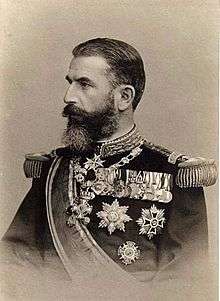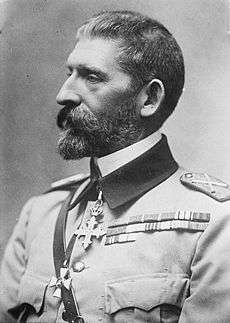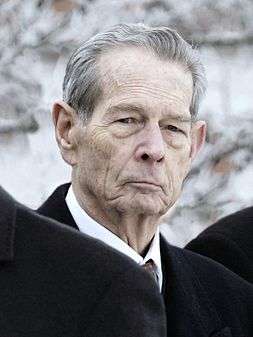King of the Romanians
| King of the Romanians | |
|---|---|
|
| |
|
Michael I | |
| Details | |
| Style | His Majesty |
| First monarch | Carol I |
| Last monarch | Michael I |
| Formation | 15 March 1881 |
| Abolition | 30 December 1947 |
| Residence | Royal Palace |
| Appointer | Hereditary |
| Pretender(s) | Margareta |
The King of the Romanians (Romanian: Regele Românilor)[1] was the sovereign ruler of the Kingdom of Romania from 1881 until 1947, when Romania was proclaimed a People's Republic following Michael I's forced abdication.
History
The state had been internationally recognized as a Principality since 1862, after the creation of the United Principalities, a personal union between Moldavia and Wallachia, at that time vassal states of the Ottoman Empire. Alexander I became Domnitor (ruling prince) after the official unification of the two formerly separate states, being elected prince of both states in 1859. He was deposed in 1866 by a broad coalition of the main political parties, after which Parliament offered the throne to Karl Hohenzollern who subsequently became the new "Domnitor of Romania" (as Carol I).
Romania's independence from the Ottoman Empire was recognized in 1878 by the Treaty of Berlin. In an expression of full sovereignty, the principality was elevated to a kingdom in 1881, with Carol I becoming King of the Romanians.[2] Carol I died in 1914, and was succeeded by his nephew, Ferdinand I.
In 1927, Ferdinand I died, and the country was left in the care of a Regency headed by Nicholas Hohenzollern, during the young reign of Ferdinand's grandson, Michael I (who was only six years old at the time), his father (Carol II) having renounced the throne in 1925. Carol II, unlike Carol I, in the beginning had no desire to rule Romania, and was frequently out of the country exploring the rest of Europe with his mistress. Michael's first reign would be short lived at only three years, until his father Carol II came back to contest the title at the behest of a dissatisfied political faction that staged a sudden 'coup d'état' (in spite of the fact that only a few years earlier he had renounced in official documents, written and signed in front of his own father, all his future claims to the throne of Romania).
After a ten-year rule, Carol II was forced to give up his crown in the wake of an outcry over the Second Vienna Award, which forced Romania to surrender northern Transylvania to Hungary. After the war, he married his longtime mistress, Elena Lupescu. The couple ultimately settled in Portugal, and the "playboy king" never returned to Romania.
The kingdom of Romania was a constitutional monarchy for most of its existence with the exception of 1938–1944, during the dictatorships of Carol II (1938–1940) and Ion Antonescu (1940–1944). On 23 August 1944, Michael I restored the last democratic royal Constitution of 1923. However, during his second reign (1940–1947), Michael I reigned mostly as an extraconstitutional king, without a constitutional oath or a parliamentary vote. Parliament was initially suspended and reinstated only later, in 1946. Michael I was instead crowned[3] and anointed by the Orthodox Patriarch, Nicodim Munteanu, in the Patriarchal Cathedral of Bucharest, on the day of his second accession, 6 September 1940.[4] However, legally, Michael I could not exercise much authority besides some prerogatives such as being the Supreme Head of the Army and designating a plenipotentiary Prime Minister Conducător ("Leader").[5]
On 23 August 1944, with the Soviet Army already deep inside Romania's territory, Michael I deposed the German-allied dictator Ion Antonescu at the urging of the opposition parties and aligned the country with the Allies. Helped by the presence of Soviet forces, communists gradually took control of the administration. On 30 December 1947, King Michael I was forced to sign his abdication. He has claimed to be threatened on that occasion by the killing of more than 1000 students, that had been arrested two years earlier, during a large pro-monarchic demonstration held on November 8, 1945, and that were still illegally detained. The same day, Parliament proclaimed the country a people's republic. The young King and Queen-Mother Elena were forced to leave Romania on January 3, 1948, in the Royal Train, at the request of the communist-dominated government, after confiscation of the Royal properties.
Return from exile
After the Revolution of 1989, the former King visited Romania to an enthusiastic reception in the streets of Bucharest; however, the country preserved its republican character. The royal estates and properties in Romania were restored.
The former King is respected and recognised by the parliament. His grandson[6] regularly visits different organisations in Romania. Princess Margarita and her husband bestow royal orders in name of the former King for selected Romanians.
The Royal house is still very popular[7] and in 2014 Prime Minister Victor Ponta promised a referendum on whether or not to reinstate the monarchy if he was re-elected.[8] A square was named in honor of King Mihai in 2012.[9]
Kings of the Romanians (1881–1947)
| Name |
Lifespan |
Reign start |
Reign end |
Notes |
Family |
Image |
|---|---|---|---|---|---|---|
| Carol I
|
20 April 1839 – 10 October 1914 (aged 75) | 15 March 1881 | 10 October 1914 | — | Hohenzollern-Sigmaringen |  |
| Ferdinand I
|
24 August 1865 – 20 July 1927 (aged 61) | 10 October 1914 | 20 July 1927 | Nephew of Carol I | Hohenzollern-Sigmaringen |  |
| Michael I (1st reign) [10] |
25 October 1921 | 20 July 1927 | 8 June 1930 | Grandson of Ferdinand I | Hohenzollern-Sigmaringen | .jpg) |
| Carol II
|
15 October 1893 – 4 April 1953 (aged 59) | 8 June 1930 | 6 September 1940 | Son of Ferdinand I | Hohenzollern-Sigmaringen |  |
| Michael I (2nd reign) [11] |
25 October 1921 | 6 September 1940 | 30 December 1947 | Son of Carol II | Hohenzollern-Sigmaringen |  |
Pretenders to the Romanian throne (since 1947)
| Pretender | Portrait | Lifespan | Pretending from | Pretending until |
|---|---|---|---|---|
| Michael I |  | 25 October 1921 | 30 December 1947 | 1 March 2016 |
| Margareta | 26 March 1949 | 1 March 2016 | Incumbent | |
Royal Consorts
- Princess Elisabeth of Wied (wife of King Carol I)
- Princess Marie of Edinburgh (wife of King Ferdinand)
Royal Standards
.svg.png) Royal Standard (1881–1922)
Royal Standard (1881–1922).svg.png) Royal Standard (1922–1947)
Royal Standard (1922–1947)
See also
- Domnitor
- List of Romanian consorts
- List of rulers of Moldavia
- List of rulers of Wallachia
- List of heads of state of Romania
- Steel Crown of Romania
- Romanian Crown Jewels
References
- ↑ "Gold set 1939". Romanian Coins. Archived from the original on October 27, 2009.
- ↑ Kremnitz, Mite; Sidney Whitman, Sidney (1899). Reminiscences of the King of Roumania. Harper& Brothers.
- ↑ "Fundamental Rules of the Royal Family of Romania" (PDF). The Romanian Royal Family website.
- ↑ "The Joys of Suffering," Volume 2, "Dialogue with a few intellectuals", by Rev. Fr. Dimitrie Bejan – "Orthodox Advices" website as of June 9, 2007 (Romanian)
- ↑ Ioan Scurtu, Theodora Stănescu-Stanciu, Georgiana Margareta Scurtu, "The History of the Romanians between 1918-1940" ("Istoria românilor între anii 1918–1940"), p. 280. (Romanian)
- ↑ http://www.euractiv.com/countries/romania-discreet-scent-monarchy-analysis-515175
- ↑ http://www.economist.com/blogs/eastern-approaches/2011/10/romanias-ex-monarchy Long live the ex-king
- ↑ http://royalcentral.co.uk/foreignroyals/romania-may-hold-a-referendum-on-the-return-of-monarchy-38884 Romania may hold a referendum on the return of Monarchy
- ↑ http://www.reuters.com/article/2012/10/25/us-romania-monarchy-idUSBRE89O0OP20121025 Romania government honors ex-king on 91st birthday
- ↑ Nicholas Hohenzollern ruling as Prince Regent.
- ↑ With Ion Antonescu as Conducător, from 6 September 1940 to 23 August 1944.
